No.259 - "ニーベルングの指環" 入門(3)愛 [EX.80-114] [音楽]
|
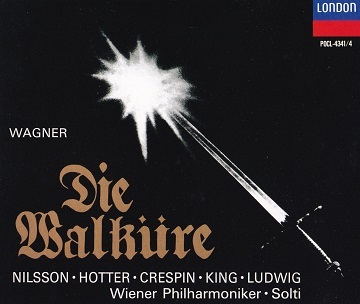
| ||
|
リヒャルト・ワーグナー
「ワルキューレ」
ゲオルグ・ショルティ指揮
ウィーン・フィルハーモニー管弦楽団 (新リマスター版CD 1997。録音 1965) | ||
CD1-Track15
Love is another of the central symbols of the drama, standing in direct opposition to the two central symbols of power, the Ring and the Spear. In the first place, it stands naturally in opposition to the Ring because the crucial condition attached to the making of the Ring is the Renunciation of Love. And this condition has its own motive, a tragic one in the minor key. It enters in Scene 1 of Rheingold. It's sung by the Rhinemaiden, Woglinde, when she tells Alberich that only the man who is prepared to renounce love can make the Ring from the Gold.
"愛" はドラマのもう一つの中心的なシンボルであり、それは "力" の中心的シンボルの2つ、"指環" と "槍" のちょうど正反対の位置にあります。そもそも "愛" が "指環" の対極にあるのは当然でしょう。なぜなら、指環を作る際の絶対の条件が《愛の断念》だからです。この条件は、それ自身を表す悲劇的な短調のモティーフを持っています。これは『ラインの黄金』の第1場で導入され、ラインの乙女のヴォークリンデによって歌われます。彼女がアルベリヒに、愛を断念する用意がある者だけが黄金から指環を作れる、と告げる場面です。
| EX.80: 《愛の断念》 |

This motive of the Renunciation of Love recurs at various points in the drama, most surprisingly perhaps, in Act 1 of Walkure. Siegmund sings it as he draws the Sword from the Tree, the decisive action which proclaims his identity as the brother of Sieglinde and her true lover.
《愛の断念》のモティーフはドラマの数々の時点で再現します。驚くことに『ワルキューレ』の第1幕でもジークムントが剣を樹から抜く時に歌います。彼はこの決断の行動で、ジークリンデの兄であると同時に真の恋人である自覚を宣言するのです(訳注:第1幕 第3場の最終場面)。
| EX.81: 《愛の断念》 ジークムント形 |
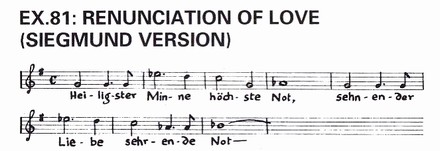
Siegmund's words refer to the need for which he has drawn the Sword, the deepest need of holiest love. From the total symbolic point to view, the whole drama, The Ring has begun in the world without love, and this is symbolized by the Renunciation motive. The claims of love only begin to assert themselves in Act 1 of Walkure, and they're only established in Act 3 in the Compassionate Love of Brunnhilde represented by the motive we heard a little earlier.
Wotan himself, in his own way, has renounced love as decisively as Alberich by offering Freia, the Goddess of Love, as a wage to the Giants for building Valhalla. And so the Renunciation motive is also associated with him, though in a different form. This stems from the second of the two phrases in the original motive. And the agent of transformation is Fricka in Scene 2 of Rheingold, when she tells Wotan that his bartering away of Freia shows his contempt for love. Here's the second phrase of the Renunciation motive as sung originally by Woglinde.
ジークムントは剣を抜く理由になった崇高な愛への深い欲求を語ります。象徴性の視点からドラマ全体を見ると『指環』は "愛なき世界" で始まり、《断念》のモティーフがそれを象徴します。愛への要求は『ワルキューレ』の第1幕でようやく主張され、第3幕の《ブリュンヒルデの哀れみの愛》で確立されます。そのモティーフは少し前に聴きました(訳注:EX.79)。
ヴォータンもアルベリヒと同様、彼なりのやり方で完全に愛を断念しました。つまり、ヴァルハラを建てた労賃として愛の女神であるフライアを巨人たちに差し出したからです。従って《断念》のモティーフは、少し違った形ですがヴォータンとも結びつきます。これは元々のモティーフの2つあるセグメントの2番目から生じます。そのモティーフの変形を担当するのが『ラインの黄金』第2場でのフリッカです。そのときフリッカは、ヴォータンがフライアを交換で手放したのは愛への侮辱だとヴォータンに言います。次が、ヴォークリンデが歌う元々の《断念》のモティーフの第2セグメントです。
ヴォータンもアルベリヒと同様、彼なりのやり方で完全に愛を断念しました。つまり、ヴァルハラを建てた労賃として愛の女神であるフライアを巨人たちに差し出したからです。従って《断念》のモティーフは、少し違った形ですがヴォータンとも結びつきます。これは元々のモティーフの2つあるセグメントの2番目から生じます。そのモティーフの変形を担当するのが『ラインの黄金』第2場でのフリッカです。そのときフリッカは、ヴォータンがフライアを交換で手放したのは愛への侮辱だとヴォータンに言います。次が、ヴォークリンデが歌う元々の《断念》のモティーフの第2セグメントです。
| EX.82: 《愛の断念》 第2セグメント |
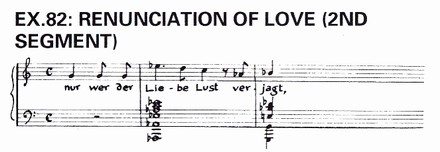
When Fricka accuses Wotan of despising love, the orchestra plays the first phrase of the Renunciation motive, but her utterance ends by hinting harmonically at this second one.
フリッカがヴォータンの愛への侮辱を責めるとき、オーケストラは《断念》のモティーフの第1セグメントを演奏します。しかし彼女の歌唱はこの第2セグメントの和声を暗示して終わります。
| EX.83: 《愛の断念》 第2形への移行 |
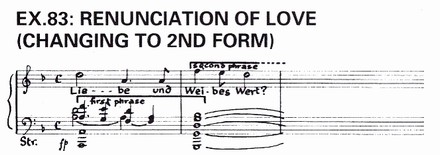
CD1-Track16
Later in the same Scene, Loge acts as a final agent of transformation when he says that, in all the world, he's been unable to find anything valuable enough to serve as a substitute wage for the Giants instead of the Goddess of Love, Freia. Here, he adapts the phrase of Fricka, which we've just heard, into the second form of the Renunciation motive which is to be associated with Wotan, and later with other characters.
同じ『ラインの黄金』第2場の後の方で、ローゲが《断念》の最後の変形を担当します。世界中を探したが、巨人たちへの報酬として愛の女神フライアの代わりなる価値あるものは見つけられなかったと彼が言う場面です。ここでローゲは先ほど聴いたフリッカのフレーズを《断念》のモティーフの第2形へと改変します。これはヴォータンに関連づけられ、後には他の登場人物とも結びつきます。
| EX.84: 《愛の断念》 第2形 |

This second form of the Renunciation motive often recurs as a mournful cadence expressing futility. One of the many examples is to be found in Act 2 of Walkure when Wotan, having realized his own lovelessness, describes himself as the unhappiest of men. Here's the whole passage, leading up to the use of the Renunciation motive as a cadence.
この《断念》のモティーフの第2形は、しばしば無益な行為を表現する "嘆きの終止形" として再現します。その多数の例の中の一つは、『ワルキューレ』の第2幕でヴォータンが愛の欠如を自覚し、最も不幸な男だと自身を表現するときに認められます。ここで《断念》のモティーフを終止形として使うに至る全体のパッセージを聴いてみましょう(第2幕 第2場。EX.76 の直後)。
| EX.85: 《愛の断念》 ヴォータンによる第2形 |
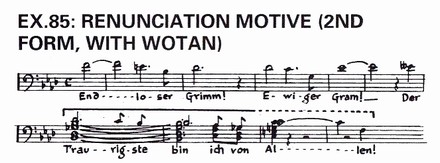
But the Renunciation motive in both its forms only represents love in a negative light, it stands for the general lovelessness prevailing in the power ridden world of the drama.
The basic love motive, positive, dynamic motive of love in action, in opposition to absolute power, is the one associated with the central symbol of love in the drama, the Goddess of Love herself, Freia. Her motive first enters on the orchestra in Scene 2 of Rheingold when she runs on persued by the Giants. Fricka describes her approach and Freia enters her motive introduced by the violins.
しかし《断念》のモティーフの2つの形とも "愛" の否定的側面だけを表しており、"力" が支配する世界に蔓延する愛の欠如を表現しています。
その絶対的な "力" に対抗し、肯定的で、実際の愛のように動的な基本モティーフがあります。それは、このドラマの中心的な愛のシンボル、愛の女神・フライア自身に関連づけられたモティーフです。フライアのモティーフは最初に『ラインの黄金』の第2場でオーケストラに現れます。そのとき彼女は巨人たちの追跡から逃れてきます。フリッカが彼女の接近を告げ、フライアが登場するときに、彼女のモティーフがヴァイオリンに導入されます。
その絶対的な "力" に対抗し、肯定的で、実際の愛のように動的な基本モティーフがあります。それは、このドラマの中心的な愛のシンボル、愛の女神・フライア自身に関連づけられたモティーフです。フライアのモティーフは最初に『ラインの黄金』の第2場でオーケストラに現れます。そのとき彼女は巨人たちの追跡から逃れてきます。フリッカが彼女の接近を告げ、フライアが登場するときに、彼女のモティーフがヴァイオリンに導入されます。
| EX.86: 《フライア》 |
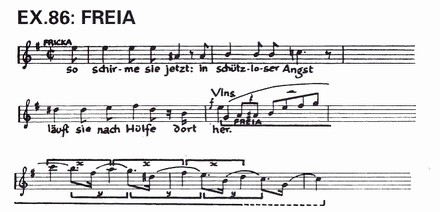
We can hear Freia's swift motive more clearly from another special illustration, the violin part played on its own, a little more slowly.
《フライア》のテンポの速いモティーフは、特別の例示でもっと明確に聴けます。ヴァイオリンのパートだけを少しゆっくりと演奏してみましょう。
| EX.87: 《フライア》 ヴァイオリン・パート |

CD1-Track17
Freia's motive has two independent segments and we may begin by considering the first, the rising one.
《フライア》のモティーフは独立した2つのセグメントを持っています。まず、最初の上昇するセグメントから考察してみましょう。
| EX.88: 《フライア》 第1セグメント |

This first segment of Freia's motive is swift here and in the minor to portray Freia's agitation as she flees from the Giants. But it soon establishes its definitive slow major form. This stands out clearly for the first time when it introduces Loge's 'Hymn to Love', a little further along in the same Scene.
この《フライア》のモティーフの第1セグメントは速いテンポの短調で、巨人たちから逃走するフライアの切迫感を描いています。しかしまもなく、ゆっくりとした長調の確定形になります。これは同じ場の少し後でローゲが "愛の賛歌" を歌うとき、初めてはっきりと目立つ形で現れます(訳注:第2場の EX.84 の直後)。
| EX.89: 《フライア》 第1セグメント - 確定形 |

This definitive sinuous form of the first segment of Freia's motive recurs on its own throughout The Ring in association with the sensuous aspect of love between man and woman. For example, in Act 1 of Walkure, after Siegmund's first fully impassioned utterance to Sieglinde, it ascends sweetly on the violins.
このしなやかな《フライア》の第1セグメントの確定形は『指環』全体で再現します。それは男女の愛の官能的な側面に関連づけられます。例えば『ワルキューレ』の第1幕でジークムントがジークリンデに最初の情熱的な言葉を口にするとき、このモティーフがヴァイオリンで甘美に上昇します(訳注:第1幕 第3場)。
| EX.90: 《フライア》 第1セグメント - ジークムントとジークリンデ |
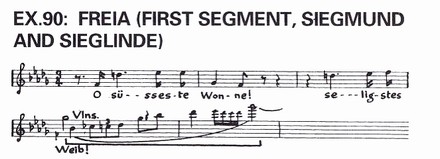
No new motives are generated from this first segment of Freia's motive. It remains itself throughout The Ring. The whole family of motives representing the various aspect of love is generated by the second segment of her motive which we'll recall now.
《フライア》のモティーフの第1セグメントから新しいモティーフは生成されません。これは『指環』全体を通してそのままの形で残ります。愛のさまざまな側面を表すモティーフのファミリー全体は、《フライア》のモティーフの第2セグメントから生成されます。第2セグメントを思い出してみましょう。
| EX.91: 《フライア》 第2セグメント |

This second segment of Freia's motive was identified wrongly by the very first commentator on The Ring, Hans von Wolzogen. He labeled it Flight. And every commentator since has followed him unthinkingly.
The whole motive enters in conjunction with Freia, and as with many other motives, its segments apply equally to the symbol it's attached to. It was not Wagner's practice to detach segments of his motives from the symbols that are initially associated with, and give them quite different meanings.
この《フライア》のモティーフの第2セグメントは、『指環』の最初の解説者であるハンス・フォン・ヴォルツォーゲンによって間違った認識がされました。彼は《逃亡》と名づけたのです。そして後世の全ての解説者は、考えなしにそれに従いました。
しかしモティーフ全体がフライアと結びついて登場しており、他のモティーフと同様、全てのセグメントが表現しているシンボルに等しく適用されるはずです。あるモティーフが最初にシンボルに関連づけられたあとで、モティーフのセグメントを切り離して全く違った意味を与えるというのは、ワーグナーの流儀ではありません。
しかしモティーフ全体がフライアと結びついて登場しており、他のモティーフと同様、全てのセグメントが表現しているシンボルに等しく適用されるはずです。あるモティーフが最初にシンボルに関連づけられたあとで、モティーフのセグメントを切り離して全く違った意味を与えるというのは、ワーグナーの流儀ではありません。
CD1-Track18
The label Flight might at times seem to be justified, since the segment does recur in something like its original form when various characters are in flight. For example, it portrays Siegmund and Sieglinde fleeing from Hunding in the Prelude to Act 2 of Walkure.
《逃亡》という名前は、時に正当化できるように思えるかも知れません。というのもこの第2セグメントは原形に近い形で、さまざまな登場人物が逃げているときに出てくるからです。例えば『ワルキューレ』の第2幕への前奏曲では、フンディングから逃げるジークムントとジークリンデを描写します。
| EX.92: 《逃亡》 |

However, the characters in flight here, Siegmund and Sieglinde, are symbols of love, as Freia herself is, even when fleeing from the Giants. And if we examine the second segment of Freia's motive, we find that it functions exactly like the first segment as a love motive. In conjunction with the first segment, it soon establishes a definitive slow major form. Here's the original Freia's motive, again, complete.
しかし、ここで逃亡している登場人物のジークムントとジークリンデは愛のシンボルです。それは、たとえ巨人たちから逃げているときでもフライアが愛のシンボルであるのと同じです。そして《フライア》のモティーフの第2セグメントを調べてみると、第1セグメントと全く同じように愛のモティーフとして機能していることがわかります。それはすぐに第1セグメントと結合した形で、ゆっくりとした長調の確定形になります。《フライア》のモティーフの原形を、もう一度完全な形で聴いてみましょう。
| 《フライア》 ヴァイオリン・パート: EX.87 |

CD1-Track19
When Fasolt, in Scene 2 of Rheingold, explains Wotan that he looks forward to having Freia as a wife in his home, the oboe accompanies his vocal line with the whole of Freia's motive, both first and second segments, in the definitive slow major form.
『ラインの黄金』の第2場においてファゾルトがヴォータンに、フライアを妻として家に迎えるのを楽しみにしていると説明するとき、彼の歌唱にオーボエが伴奏します。それは《フライア》のモティーフの第1、第2セグメントを含む全体の形で、ゆっくりとした長調の確定形です。
| EX.93: 《完全なフライア》 確定形 |
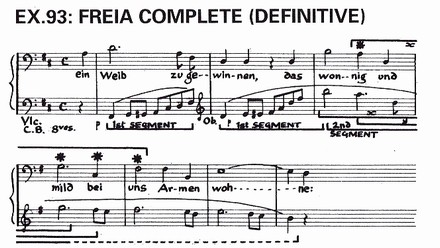
And the second segment of Freia's motive, in exactly the same way as the first, detaches itself in its definitive slow major form and recurs as a pure love motive in association with Siegmund and Sieglinde in Act 1 of Walkure. Here's the second segment again in its original swift minor form.
そして《フライア》のモティーフの第2セグメントは第1セグメントと全く同じように、ゆっくりとした長調の確定形で分離されます。その分離したセグメントは『ワルキューレ』の第1幕でジークムントとジークリンデに関連づけられた、純粋な愛のモティーフとして再現します。第2セグメントを、原形の速い短調の形で再度聴いてみましょう。
| 《フライア》 第2セグメント: EX.91 |

When Siegmund drinks the mead which Sieglinde has brought him and they stare into one another's eyes and fall in love, this second segment of Freia's motive enters in its definitive slow major form as their basic love motive.
ジークリンデが用意した蜂蜜酒をジークムントが飲むとき、2人は眼を見つめ合い、恋に落ちます。そのとき、この《フライア》のモティーフの第2セグメントがゆっくりとした長調の確定形で入ってきて、それは2人の愛の基本モティーフになります(訳注:第1幕 第1場)。
| EX.94: 《フライア》 第2セグメント - ジークムントとジークリンデ |
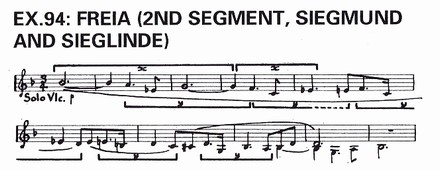
This basic love motive represents the compassionate aspect of love as opposed to its sensuous aspect which is expressed by the first segment of Freia's motive. It recurs in many different forms. Two main ones are slow and in the major, as here, and swift and in the minor, as at first, to represent love being driven out and pursued, hence the mistaken label of Flight.
There are certain passages where the swift minor form of the motive might seem to imply Flight, or at least pursuit, devoid of any associations with love. But these have been misunderstood. An example is the descent of Wotan and Loge to Nibelheim between Scenes 2 and 3 of Rheingold. Here, the second segment of Freia's motive is repeated over and over very swiftly in the minor. And a suggestion is that Wotan and Loge are in flight in some abstruse sense, or at least that they're in swift pursuit of Albrecht and the Ring.
この愛の基本モティーフは、《フライア》のモティーフの第1セグメントで表現される愛の官能的な側面とは対照的に、愛の哀れみの側面を表現しています。このモティーフは様々な形で再現します。その中心的なものは2つで、一つはここにみられるゆっくりとした長調です。もう一つは短調の速いテンポのもので、それはせき立てられ、追いかけられている愛を表現します。そのため《逃亡》という間違った名前がついたのです。
確かにこのモティーフの速い短調の形が、愛と関係がなく《逃亡》を含意するように見える、または少なくとも "追跡" と見えるパッセージもあります。しかしこれも誤解されてきました。その例は『ラインの黄金の』の第2場と第3場の間でヴォータンとローゲがニーベルハイムに下っていくシーンです。ここでは《フライア》のモティーフの第2セグメントが大変テンポの速い短調の形で何度も繰り返されます。ここでの意味は、ヴォータンとローゲが何らかの深い意味での逃亡状態にあることか、あるいは少なくとも2人がアルベリヒと指環を急いで追い求めているとも見えます。
確かにこのモティーフの速い短調の形が、愛と関係がなく《逃亡》を含意するように見える、または少なくとも "追跡" と見えるパッセージもあります。しかしこれも誤解されてきました。その例は『ラインの黄金の』の第2場と第3場の間でヴォータンとローゲがニーベルハイムに下っていくシーンです。ここでは《フライア》のモティーフの第2セグメントが大変テンポの速い短調の形で何度も繰り返されます。ここでの意味は、ヴォータンとローゲが何らかの深い意味での逃亡状態にあることか、あるいは少なくとも2人がアルベリヒと指環を急いで追い求めているとも見えます。
| EX.95: 《逃亡》ニーベルハイムへの下降 |
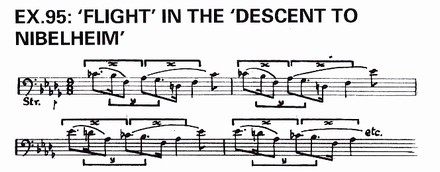
To understand the true significance of this passage, we have to realize that the origin of the second segment of Freia's motive, the basic love motive, goes back beyond Freia herself to Scene 1 of Rheingold. Here, a short embryonic form of it is introduced in association with the thwarting of Alberich passion by the Rhinemaidens. When Alberich is finally rejected by the third Rhinemaiden, Flosshilde, he introduces this embryonic form of the basic love motive rather slowly and in the minor to express his grief over the frustration of his wooing.
このパッセージの真の意味を理解するためには、愛の基本モティーフである《フライア》のモティーフの第2セグメントの起源が、『ラインの黄金』でのフライアの登場より前の第1場にあることを理解しなければなりません。つまりアルベリヒのラインの乙女に対する熱情が挫折することに関連して、愛のモティーフの短い萌芽形が出てくるのです。アルベリヒが最終的に第3のラインの乙女・フロスヒルデによって拒絶されたとき、彼は愛の基本モティーフの萌芽形を導入します。それは幾分ゆっくりとした短調で、求婚が挫折に終わった嘆きを表現しています。
| EX.96: 《フライア》 第2セグメント - アルベリヒ |

It's this short embryonic version of the basic love motive which is developed in the descent to Nibelheim. To make this absolutely clear, let's hear Alberich's lament in Scene 1 again, picking up the music a little earlier beginning with his cries of "Woe is me" which lead to his embryonic version of the basic love motive.
ニーベルハイムへの下降のシーンで展開されるのは、この愛の基本モティーフの短い萌芽形です。このことを完全に明確にするために、第1場でのアルベリヒの嘆きを再度聴いてみましょう。少し前のアルベリヒの "ああ情けない" という叫びのところの音楽から取り上げますが、それが愛の基本モティーフの萌芽形へと導きます。
| EX.97: 《アルベリヒの嘆き》 |

The descent to Nibelheim takes this passage as its starting point. It restates Alberich's cries of "Woe is me" more quickly and then it develops his short embryonic version of the love motive furiously, in the way made possible by the definitive continuous form of it, now associated with Freia.
ニーベルハイムへの下降は、このパッセージが出発点になっています。まずアルベリヒの "ああ情けない" という叫びが素早く繰り返され、短い愛のモティーフの萌芽形へと激しく展開します。それが、フライアに関連づけられる確定形へと変わっていくことを可能にします。
| EX.98: 《フライア》 第2セグメント - ニーベルハイムへの下降 |
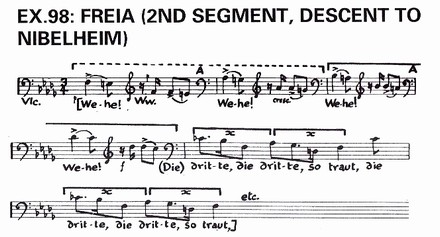
It's clear that when this passage begins, just after the music associated with Loge in Scene 2, Wagner employs a flashback technique which he often uses in orchestral interludes. He turns away from Wotan and Loge and their descent to Nibelheim, and picks up Alberich on his descent to Nibelheim from the Rhine after Scene 1. Alberich's thwarted desire a love has turned bitter, and is being transformed into a fierce lust of power,a familiar psychological phenomenon which is the true underlying meaning of the dependence of absolute power on the renunciation of love.
第2場のローゲが関係する音楽のすぐあとでこのパッセージが始まるとき、明らかにワーグナーはオーケストラ間奏曲でよく用いるフラッシュバックの技法を使っているです。ワーグナーは、ヴォータンとローゲと彼らのニーベルハイムへの下降はひとまず置いておき、第1場の最後でアルベリヒがライン河からニーベルハイムに下降するときの音楽を取り上げます。アルベリヒの愛への欲望の挫折は苦いものになり、それは力に対する激しい欲望へと変化しつつあります。愛を放棄するに当たって絶対的な力に頼るというのがその背景の意味であり、それはよくある心理現象だと言えるでしょう。
CD1-Track20
A little later in this interlude, the basic love motive enters in the new and more powerful form on the brass. It's still in the minor, but now it's slow and drawn out like the lament of love itself expelled from this world of naked power.
この間奏曲の中の少しあとで、新しい形の愛の基本モティーフがもっと力強く金管に入ってきます。それはまだ短調ですが、ゆっくりと引き伸ばされていて、むき出しの "力" の世界から追放されてしまった "愛" を嘆くようです。
| EX.99: 《フライア》 第2セグメント - ゆっくりとした短調 |

This powerful form of the basic love motive, slow and in the minor, attaches itself to Wotan in Act 2 of Walkure when he realizes his own lovelessness. He sings it at the beginning of the passage we heard earlier, the one illustrating the use of the second form of the Renunciation motive as a cadence expressing futility.
この力強く、ゆっくりとした短調の愛の基本モティーフは『ワルキューレ』の第2幕においてヴォータンに割り当てられます。彼が自分の愛の欠如を自覚するときです。彼は以前に聴いたパッセージの最初でそれを歌い、またこれは《愛の断念》のモティーフの第2形を、無益さを表す終止形として使う例になっています。
| EX.100 は第2幕 第2場で、EX.85 《愛の断念・第2形》と同じ箇所。 |
| EX.100: 《フライア》 第2セグメント - ゆっくりとした短調 |

This lamenting form of the basic love motive also attaches itself to Siegmund and Sieglinde in a more lyrical way. In Act 1 of Walkure when Siegmund momentarily feels that his love of Sieglinde is a forlorn hope, the definitive slow major form of the basic love motive which has been associated with their falling in love, now turns sadly to its minor form.
この愛の基本モティーフの "嘆きの形" は、もっと叙情的な形で『ワルキューレ』第1幕のジークムントとジークリンデに結びつきます。ジークリンデへの恋が絶望的なのではとジークムントが一瞬感じるとき、恋に落ちることに関連した愛の基本モティーフのゆっくりとした長調の確定形が、悲しげな短調の形に変わります(訳注:第1幕 第1場。EX.94 と同じ場面)。
| EX.101: 《フライア》 第2セグメント - ゆっくりとした短調 |

The definitive slow major form of the basic love motive later transformed itself freely to generate two new motives associated with the love of Siegfried and Brunnhilde in Act 3 of Siegfried. First, it forms the basis of the exultant theme known as the motive of Love's Greeting. They introduce this vocally when they hail the memory of Sieglinde as the mother of Siegfried.
ゆっくりとした長調の愛のモティーフの確定形は(訳注:EX.94)のちに自由な変形を遂げ、『ジークフリート』の第3幕においてジークフリートとブリュンヒルデの愛に結びつく新たな2つのモティーフを生み出します(訳注:第3幕 第3場)。まず《愛の挨拶》のモティーフとして知られる、喜びに溢れた旋律の基本を形づくります。2人がジークフリートの母のジーリンデの思い出を讃えるとき、歌唱でこのモティーフが導入されます。
| EX.102: 《愛の挨拶》 |
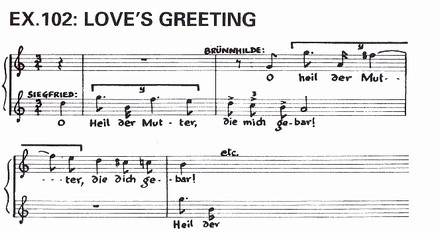
The relationship between this new motive of Love's Greeting and the basic love motive becomes entirely clear in a later passage when Brunhilde tells Siegfried that she was destined for him before he was born. This new motive enters on the woodwind, but Brunhilde immediately continues it in the shape of the basic love motive.
この新しいモティーフ《愛の挨拶》と愛の基本モティーフの関係は、後の歌唱で明らかになります。ブリュンヒルデがジークフリートに、彼が生まれる前から自分の運命づけられた人だったと告げるときです。この新しいモティーフが木管に入ってきますが、ブリュンヒルデはすぐに愛の基本モティーフの形で続きます。
| EX.103: 《愛の挨拶》 と 《フライア》の第2セグメント |
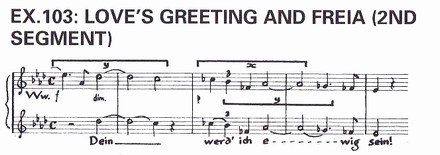
CD2-Track01
The other new motive generated by the basic love motive, is the bold one known as Love's Resolution. It strikes in nearly at the end of Siegfried to sum up the supremely confident character of the love of Siegfried and Brunnhilde. This motive is again a free transformation of the of the basic love motive. Its origin is the brilliant orchestral passage at the end of Act 1 of Walkure when Siegmund and Sieglinde fall into one another's arms. The basic love motive enters here in the major but quickly. That is developed to the swift telescoped form to express the joyful passion of the two lovers.
愛の基本モティーフから作り出される他の新しいモティーフは《愛の決心》として知られる堂々としたモティーフです。それは『ジークフリート』の終わり近くで登場し、ジークフリートとブリュンヒルデの愛が最大限に強いことを総括します。このモティーフもまた、愛の基本モティーフの自由な変形です。その原形は『ワルキューレ』の第1幕の終わりにおいて、ジークムントとジークリンデがお互いの両腕で抱き合うときにオーケストラに入ってくる輝かしいパッセージです。ここに出てくる愛の基本モティーフは長調ですが、テンポは速いものです。それは2人の恋人の喜びの情熱を表現するため、速く、縮められた形で展開されます。
| EX.104 は『ワルキューレ』第1幕 第3場で EX.81 のジークムントの歌唱のあと、幕が降りる直前のオーケストラ演奏。 |
| EX.104: 《フライア》 第2セグメント - 速い長調 |

It's this swift telescoped form of the basic love motive that broadens out majestically on the horns at the end of Siegfried to become the motive of Love's Resolution.
この、速くて縮められた形の愛の基本モティーフが『ジークフリート』の最終場面でホルンによって壮麗に展開され、《愛の決心》のモティーフとなります。
| EX.105: 《愛の決心》 |

This ends the family of motives generated by the basic love motive. But there are several other motives associated with the symbol of love which are quite independent.
First, there's the moving motive which represents the Bond of Sympathy between the Volsungs, Siegmund, Sieglinde and later it attaches itself to their son, Siegfried. It's first heard in Act 1 of Walkure. It enters in the bass with Sieglinde's motive above it when Siegmund and Sieglinde find themselves partners in distress.
これで愛の基本モティーフから作り出されたモティーフのファミリーは終わりですが、愛のシンボルに関連した、全く独立した数個のモティーフがあります。
まず《ヴェルズング族の共感の絆》を表す感動的なモティーフで、これはジークムントとジークリンデを表し、後には彼らの息子のジークフリートに結びつきます。このモティーフは最初に『ワルキューレ』の第1幕で聴かれます。ジークムントとジークリンデが互いに悩みをもつ仲間だと悟るとき、このモティーフが低音部に入ってきます。その上には《ジークリンデ》のモティーフを伴っています。
まず《ヴェルズング族の共感の絆》を表す感動的なモティーフで、これはジークムントとジークリンデを表し、後には彼らの息子のジークフリートに結びつきます。このモティーフは最初に『ワルキューレ』の第1幕で聴かれます。ジークムントとジークリンデが互いに悩みをもつ仲間だと悟るとき、このモティーフが低音部に入ってきます。その上には《ジークリンデ》のモティーフを伴っています。
| 《ジークリンデ》のモティーフについては EX.72 《ジークムントとジークリンデ》参照。《ジークリンデ》だけの解説はない。EX.106 は『ワルキューレ』第1幕 第1場の最終場面。 |
| EX.106: 《ヴェルズング族の共感の絆》 |
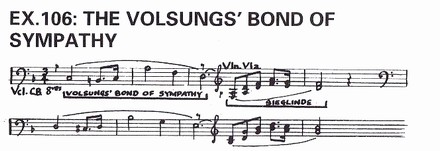
This motive is developed in several different ways throughout the whole drama. But when it later attaches itself to Siegfried, it takes on a quick excited form to express his agitation during his love scene with Brunnhilde.
このモティーフはドラマ全体を通していくつかの違った形で展開されます。しかし後にこれがジークフリートに結びつくとき、テンポを速め、興奮した形をとります。それはブリュンヒルデとの愛の場におけるジークフリートの高揚感を表しています(訳注:『ジークフリート』第3幕 第3場)。
| EX.107: 《ヴェルズング族の共感の絆》 第2形 |

Another independent love motives associated with Siegmund and Sieglinde is the melody of Siegmund song of spring, Wintersturme.
ジークムントとジークリンデに関連づけられた別の独立したモティーフがあります。それはジークムントが歌う春の歌、《冬の嵐》の旋律です(訳注:『ワルキューレ』第1幕 第3場)。
| EX.108: 《冬の嵐》 |

One of the independent love motive is associated with Wotan's Affection for Brunnhilde. He sings it near the end of Walkure just before he plunges Brunnhilde into her magic sleep.
独立した愛のモティーフの一つは、ヴォータンのブリュンヒルデへの愛情に関係しています。『ワルキューレ』の終幕近く、ブリュンヒルデを "魔の眠り" につかせる直前にヴォータンが歌います。
| このモティーフは《告別》ないしは《ヴォータンの告別》とも呼ばれる。 |
| EX.109: 《ヴォータンのブリュンヒルデへの愛情》 |
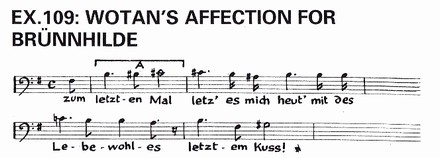
CD2-Track02
There are several independent love motives attached to Siegfried and the love between him and Brunnhilde. First, there's a yearning one associated with Siegfried's longing for human love and companionship. He is to replace Wotan in Brunnhilde's affections. And this motive begins with the same three rising chromatic notes as the one we've just heard associated with Wotan's affections for her. It enters in Act 1 of Siegfried, while Siegfried describes to Mime how he has watch the wooing and mating of the birds in the forest. It's worth noting that this motive goes straight over into the basic love motive.
さらに、ジークフリートおよび彼とブリュンヒルデの愛に結びつく数個の独立したモティーフがあります。第1に、人間愛と友情を切望するジークフリートに関連づけられる《憧れ》のモティーフです。ブリュンヒルデの愛情は、ヴォータンからジークフリート移ることになります。そしてこのモティーフは、さっき聴いた《ヴォータンのブリュンヒルデへの愛情》のモティーフと全く同じように、3つの上昇する半音階で始まります。このモティーフは『ジークフリート』の第1幕において、ジークフリートが森の小鳥たちの求愛と交尾を観察したことをミーメに語るときに入ってきます(訳注:第1幕 第1場)。このモティーフが愛の基本モティーフと直接的につながっていることに注目すべきでしょう。
| EX.110: 《ジークフリートの愛への憧れ》 |

There are four further independent love motives associated with Siegfried and Brunnhilde. The first is a jubilant leaping one which enters when Brunnhilde is fully awake and is generally known as the motive of Love's Ecstasy.
ジークフリートとブリュンヒルデに関連づけられる独立した愛のモティーフがさらに4つあります。その第1はブリュンヒルデが完全に目覚めたときに登場する、喜びに飛び跳ねるようなモティーフで、これは《愛の陶酔》のモティーフとして知られています。
| 以降の EX.111, EX.112, EX.113 は『ジークフリート』第3幕 第3場。 |
| EX.111: 《愛の陶酔》 |

Two of the other independent love motives attached to Siegfried and Brunnhilde are simply two of the themes that belong to the 'Siegfried Idyll'. The first, which is not a motive in the strict sense in that it never recurs, is the opening theme of that work which is introduced to represent Brunnhilde as the Immortal Beloved.
ジークフリートとブリュンヒルデに結びつく独立した愛のモティーフのうちの2つは、「ジークフリート牧歌」の2つの旋律と同じものです。一つは「ジークフリート牧歌」の冒頭の主題で、ブリュンヒルデを表現する《不滅の愛されし人》です。もっともこれは1回しか現れないので、厳密な意味でのモティーフだとは言えません。
| EX.112: 《不滅の愛されし人》 |

The other motive is the second theme of the 'Siegfried Idyll' which is sung by Brunnhilde to the words, 'Oh Siegfried, Treasure of the World', and has become known in consequence as the motive of the World's Treasure.
2つ目は「ジークフリート牧歌」の第2主題で、ブリュンヒルデが「おお、ジークフリート、世界の宝」と歌うときのものです。それにより《世界の宝》のモティーフとして知られています。
| EX.113: 《世界の宝》 |
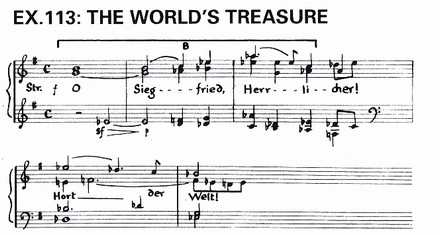
This motive does recur and derived from it is the final independent love motive, the one associated with Siegfried and Brunnhilde in Gottterdammerung, and known as the motive of Heroic Love.
このモティーフは再現し、そこから独立した愛のモティーフの最後のものが派生します。《英雄的な愛》として知られるモティーフで、『神々の黄昏』においてジークフリートとブリュンヒルデに関連づけられます。
| EX.114 は『神々の黄昏』の序幕のオーケストラ間奏のあとでブリュンヒルデが登場する場面。 |
| EX.114: 《英雄的な愛》 |

Here, we finish with the motives associated with the central symbol of love.
これで、"愛" という中心的シンボルに関連づけられたモティーフを終わります。
ライトモティーフ譜例一覧(3)
|
| 愛 |
| 《 | 愛の断念》 | |||
| 《 | 愛の断念》ジークムント形 | |||
| 《 | 愛の断念》第2セグメント | |||
| 《 | 愛の断念》第2形への移行 | |||
| 《 | 愛の断念》第2形 | |||
| 《 | 愛の断念》ヴォータンによる第2形 | |||
| 《 | フライア》 | |||
| 《 | フライア》ヴァイオリン・パート | |||
| 《 | フライア》第1セグメント | |||
| 《 | フライア》第1セグメント - 確定形 | |||
| 《 | フライア》第1セグメント - ジークムントとジークリンデ | |||
| 《 | フライア》第2セグメント | |||
| 《 | 逃亡》 | |||
| 《 | 完全なフライア》確定形 | |||
| 《 | フライア》第2セグメント - ジークムントとジークリンデ | |||
| 《 | 逃亡》ニーベルハイムへの下降 | |||
| 《 | フライア》第2セグメント - アルベリヒ | |||
| 《 | アルベリヒの嘆き》 | |||
| 《 | フライア》第2セグメント - ニーベルハイムへの下降 | |||
| 《 | フライア》第2セグメント - ゆっくりとした短調 | |||
| 《 | フライア》第2セグメント - ゆっくりとした短調 | |||
| 《 | フライア》第2セグメント - ゆっくりとした短調 | |||
| 《 | 愛の挨拶》 | |||
| 《 | 愛の挨拶》と《フライア》の第2セグメント | |||
| 《 | フライア》第2セグメント - 速い長調 | |||
| 《 | 愛の決心》 | |||
| 《 | ヴェルズング族の共感の絆》 | |||
| 《 | ヴェルズング族の共感の絆》第2形 | |||
| 《 | 冬の嵐》 | |||
| 《 | ヴォータンのブリュンヒルデへの愛情》 | |||
| 《 | ジークフリートの愛への憧れ》 | |||
| 《 | 愛の陶酔》 | |||
| 《 | 不滅の愛されし人》 | |||
| 《 | 世界の宝》 | |||
| 《 | 英雄的な愛》 |

|
2019-05-24 17:46
nice!(1)



